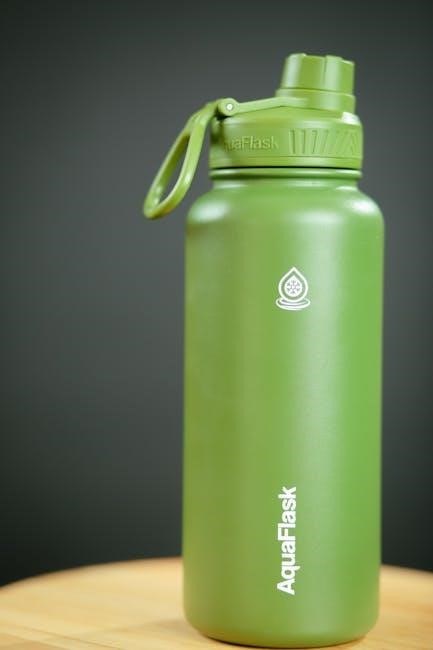The container exercise is a powerful mental tool designed to help manage overwhelming emotions and thoughts by creating a symbolic space for containment. This technique‚ often used in therapy‚ provides a structured approach to temporarily store distressing feelings‚ allowing individuals to address them when ready. Supported by downloadable PDF guides and scripts‚ it offers a practical solution for emotional regulation and well-being.
1.1 What is the Container Exercise?
The container exercise is a cognitive and emotional regulation technique that involves visualizing a symbolic space to temporarily store distressing thoughts and feelings. This mental tool allows individuals to create a boundary between themselves and overwhelming emotions‚ providing a sense of control. The exercise is often guided by structured scripts and PDF resources‚ making it accessible for both therapists and individuals. By imagining a secure container‚ such as a box or safe‚ users can mentally place their concerns inside‚ sealing them until they are ready to process them. This practice helps manage emotional overload and promotes temporary relief.
1.2 Importance of the Container Exercise in Managing Distress
The container exercise is vital for managing distress as it provides a structured method to temporarily store overwhelming emotions and thoughts. By creating a mental space‚ individuals can prevent emotional overload and regain control. This technique is particularly useful in situations where immediate processing of distress is impractical‚ offering a sense of security and emotional distance. It serves as a versatile tool for various forms of distress‚ such as anxiety‚ intrusive thoughts‚ or emotional turmoil‚ allowing individuals to address their challenges when they are better equipped. This approach enhances emotional regulation and supports overall well-being.

Understanding the Concept of the Container
The container is a mental tool for managing distress‚ serving as a temporary holding space for overwhelming emotions and thoughts‚ allowing individuals to regain emotional control and clarity.

2.1 Visualization of the Container
Visualization is a key component of the container exercise‚ where individuals imagine a secure‚ personal space to hold distressing thoughts. This mental container can take many forms—a box‚ jar‚ safe‚ or even a natural element like a cave. The container’s size‚ shape‚ material‚ and color should resonate with the individual‚ evoking feelings of safety and strength. The visualization process involves detailing its texture‚ weight‚ and any unique features‚ ensuring it feels capable of securely holding emotions. The more vivid the imagery‚ the more effective the container becomes as a tool for temporary emotional containment and regulation.
2.2 Symbolic Representation of the Container
The container serves as a symbolic mental space‚ representing safety and control over emotions. Its form—whether a box‚ jar‚ safe‚ or cave—carries personal significance‚ embodying strength and security. The container’s symbolism lies in its ability to hold and protect distressing thoughts‚ acting as a buffer between the individual and overwhelming feelings. By choosing a container that resonates with them‚ individuals create a meaningful boundary‚ reinforcing their sense of agency over their emotions. This symbolic representation empowers individuals to manage distress effectively‚ fostering emotional balance and regulation.
2.3 The Role of the Container in Emotional Regulation
The container exercise plays a crucial role in emotional regulation by providing a structured method to manage overwhelming thoughts and feelings. It acts as a mental buffer‚ reducing the immediate intensity of distressing emotions and allowing individuals to defer processing until they are in a more stable state. By creating a symbolic space to contain emotions‚ the container helps prevent emotional overload and supports a sense of control. This technique fosters emotional resilience by enabling individuals to pause‚ reflect‚ and address challenges with greater clarity‚ ultimately enhancing their overall emotional well-being and ability to cope with distressing situations effectively.
Benefits of the Container Exercise

The container exercise reduces overwhelming thoughts‚ enhances focus‚ and improves emotional well-being by providing a structured method to manage distress‚ fostering resilience and clarity in challenging situations.
3.1 Reducing Overwhelming Thoughts and Feelings
The container exercise effectively helps in managing overwhelming thoughts and emotions by providing a mental space to temporarily store distressing content. By visualizing a secure container‚ individuals can transfer their burdensome thoughts and feelings into it‚ reducing mental clutter and creating emotional distance. This process prevents emotions from spiraling out of control‚ allowing individuals to regain a sense of balance and composure. The container acts as a protective barrier‚ enabling one to defer processing until they are more resourced‚ thereby alleviating immediate emotional overload and fostering resilience. This technique is particularly useful for managing anxiety‚ intrusive thoughts‚ and intense emotional surges.
3.2 Enhancing Focus and Concentration
The container exercise enhances focus and concentration by clearing mental clutter caused by intrusive thoughts. By visualizing and transferring distressing thoughts into the container‚ individuals create a clearer mental space‚ allowing them to prioritize tasks and maintain attention. This technique is particularly useful during emotional turmoil‚ as it helps reduce distractions and promotes a sense of clarity. The act of sealing the container symbolizes setting aside mental interruptions‚ enabling greater concentration on present activities. Over time‚ this practice strengthens mental discipline‚ making it easier to stay focused and productive‚ even in challenging situations.
3.4 Improving Emotional Well-being
The container exercise improves emotional well-being by reducing emotional overwhelm and fostering resilience. By temporarily containing distressing thoughts‚ individuals prevent emotions from spiraling out of control‚ creating space for calm reflection. This technique promotes a sense of control and emotional distance‚ enabling better management of challenging feelings. Regular practice strengthens emotional regulation‚ enhancing overall mental health; While it’s a short-term solution‚ the container exercise can be a transformative tool in building long-term emotional stability and well-being.

Creating Your Mental Container
Creating a mental container involves visualizing a secure‚ personalized space to hold distressing thoughts. Focus on its appearance‚ material‚ and features to ensure it feels safe and strong.
4.1 Personalizing the Container
Personalizing your mental container is a unique process that reflects your preferences and emotional needs. Start by visualizing a space or object that feels secure and resonates with you‚ such as a box‚ jar‚ or safe. Consider its size‚ shape‚ and material—ensure it is sturdy enough to hold distressing thoughts. The container should symbolize strength and safety‚ whether through reinforced steel‚ a natural element‚ or a familiar object. Experiments with different images until one feels right‚ fostering a sense of control and security. The goal is to create a vivid‚ detailed mental space that aligns with your personal experiences and emotions.
4.2 Key Elements of an Effective Container
An effective container must possess key elements to ensure its functionality. Durability is crucial‚ as it must withstand the intensity of emotions it holds. Materials like reinforced steel or sturdy natural elements symbolize resilience. Security is another vital aspect‚ requiring features like a lock or impenetrable lid to prevent emotional leakage. Size matters‚ as the container should comfortably accommodate all distressing thoughts without overflowing. Personal resonance is equally important‚ ensuring the container feels safe and aligns with your preferences. These elements work together to create a secure‚ reliable space for emotional containment‚ empowering you to manage distress effectively.
4.3 Visualizing the Container’s Details
Visualizing the container’s details is essential for its effectiveness. Start by defining its size‚ shape‚ and material‚ ensuring it feels sturdy and secure. Consider its texture and color‚ making it visually appealing and personally meaningful. Add a secure lid or lock to symbolize containment. The more vivid your imagery‚ the stronger the container becomes. Incorporate unique features‚ like handles or symbols‚ to enhance its personal significance. The goal is to create a vivid‚ mental image that resonates with your sense of safety and control‚ making the container a reliable tool for managing distressing thoughts and emotions effectively.

Practicing the Container Exercise
Regular practice involves identifying distressing thoughts‚ visualizing their transfer into the container‚ and sealing it securely. This routine helps reinforce emotional control and mental clarity over time.
5.1 Identifying Distressing Thoughts or Feelings
Identifying distressing thoughts or feelings is the first step in practicing the container exercise. This involves recognizing specific emotions‚ worries‚ or memories that feel overwhelming or intrusive. Start by acknowledging the sensations in your body and the emotions they evoke. Be precise about what you want to contain‚ whether it’s anxiety‚ anger‚ or sadness. Focus on the present moment and allow yourself to observe these feelings without judgment. The goal is to clearly define what needs to be placed in the container‚ ensuring you address the root of your distress. This step sets the foundation for effectively managing your emotions.
5.2 Transferring Thoughts into the Container
Once distressing thoughts or feelings are identified‚ the next step is to transfer them into the container. This involves visualizing the process of placing these emotions into the mental space you’ve created. Imagine taking each thought or feeling and gently depositing it into your container. Use imagery that feels natural to you‚ such as using your hands‚ a shovel‚ or even a beam of light to move the emotions. Ensure the container is secure‚ with a clear mechanism for closing it‚ like a lid or lock. This act symbolizes temporary containment‚ allowing you to manage emotions without suppression‚ creating space for calm and clarity.
5.3 Sealing the Container
Sealing the container is a crucial step to ensure emotions remain contained; Visualize a secure lid‚ lock‚ or impenetrable barrier to prevent thoughts from escaping. This action reinforces control‚ providing a sense of safety. The sealing process finalizes the temporary storage‚ allowing individuals to focus on the present without emotional overwhelm. It symbolizes readiness to address the contained emotions later when better equipped. The container should feel secure‚ giving confidence that its contents are safely held. This step is vital for effective emotional regulation and prepares the mind for future processing when calm and resourced.
Accessing and Processing the Container

Accessing the container involves scheduling time to revisit its contents mindfully. Approach with curiosity‚ examining thoughts and emotions without judgment. This step enables deliberate processing and healing.
6.1 Scheduling Time to Revisit the Container

Scheduling time to revisit the container is essential for effective processing. Set aside a specific‚ quiet moment each day or week to ensure consistency. Choose a time when you feel grounded and prepared to engage with your emotions. Early morning or evening can be ideal‚ as these periods often provide a calm environment; Create a routine to reinforce this practice‚ making it a habit to return to your container mindfully. This structured approach helps maintain emotional balance and ensures that distressing thoughts are addressed thoughtfully‚ rather than being left unattended.
6.2 Approaching the Container Mindfully
Approaching the container mindfully involves cultivating a calm and non-judgmental state of mind. Begin by grounding yourself through deep breathing or a brief meditation to ensure emotional readiness. When opening the container‚ do so with curiosity rather than fear‚ reminding yourself that you are in control. Avoid rushing the process; instead‚ allow yourself to gradually reconnect with the stored emotions or thoughts. This mindful approach fosters a safe and reflective environment‚ enabling you to engage with the contents purposefully and without overwhelm. It’s a practice that strengthens emotional resilience and promotes intentional processing.
6.3 Examining and Processing the Contents
Examining and processing the contents of your container involves a gentle and intentional approach. Start by acknowledging the emotions or thoughts stored within‚ without judgment. Identify patterns or underlying causes that may have contributed to your distress. This step requires self-compassion and curiosity‚ allowing yourself to understand the significance of each item. Journaling or discussing with a therapist can deepen insights. The goal is to release what no longer serves you‚ integrating lessons learned. This process fosters healing and growth‚ transforming stored distress into meaningful understanding and emotional freedom.
Real-Life Applications of the Container Exercise
The container exercise is widely applied to manage anxiety‚ intrusive thoughts‚ and emotional turmoil. It enhances focus during stress and supports mental clarity‚ aiding daily well-being.
7.1 Managing Anxiety and Panic
The container exercise is a valuable technique for managing anxiety and panic by creating a mental space to temporarily store overwhelming emotions. By visualizing a secure container‚ individuals can symbolically place their distressing thoughts inside‚ reducing their immediate impact. This creates emotional distance‚ preventing anxiety from escalating. The container acts as a protective barrier‚ allowing individuals to regain control over their mental state. It is particularly effective during intense emotional surges‚ providing a sense of safety and control. Regular practice of this technique can enhance emotional resilience‚ offering a practical tool for managing anxiety and panic in daily life.
7.2 Handling Intrusive Thoughts
The container exercise is an effective strategy for managing intrusive thoughts by providing a mental space to temporarily store them. By visualizing a secure container‚ individuals can symbolically place intrusive thoughts inside‚ preventing them from overwhelming the mind. This technique helps create emotional distance‚ reducing the disruptive impact of these thoughts. The container acts as a protective barrier‚ allowing individuals to focus on the present moment. Regular practice can enhance mental clarity and reduce the distress caused by intrusive thoughts‚ offering a practical tool for maintaining emotional balance and well-being in daily life. It empowers individuals to regain control over their mental space.
7.3 Maintaining Focus During Emotional Turmoil
The container exercise is a valuable tool for maintaining focus during emotional turmoil by creating mental clarity. By visualizing a secure container‚ individuals can temporarily store overwhelming thoughts‚ reducing mental clutter. This allows them to concentrate on tasks or remain present in stressful situations. The exercise helps establish boundaries between distressing emotions and immediate responsibilities. Securing the container reinforces a sense of control‚ enabling individuals to address challenges more effectively. Regular practice of this technique enhances emotional resilience‚ making it easier to stay focused even when emotions feel overwhelming. It provides a practical method to manage distractions and maintain productivity during difficult times.
Limitations of the Container Exercise
The container exercise is a temporary solution‚ not a permanent fix for emotional distress. It requires consistent practice and may need professional guidance for deeper healing.
8.1 Temporary Solution vs. Long-Term Healing
The container exercise offers a temporary way to manage distressing thoughts and emotions‚ providing relief in the moment. However‚ it is not a substitute for long-term healing‚ as it does not resolve underlying issues. While it helps contain emotions for later processing‚ sustained well-being requires deeper therapeutic work. Over-reliance on the container without addressing root causes may hinder progress. Professional guidance is often necessary to integrate this tool into a broader healing strategy‚ ensuring that temporary relief leads to lasting emotional resolution and personal growth.
8.2 The Need for Professional Guidance
While the container exercise is a valuable tool for managing distress‚ professional guidance is essential for its effective use and integration into a broader therapeutic plan. Therapists can provide structured scripts and techniques‚ such as those found in EMDR container exercise resources‚ to enhance its benefits. They also help individuals process the contained emotions and address underlying issues‚ preventing the exercise from becoming a mere avoidance strategy. Without professional support‚ users may struggle to fully resolve the stored emotions‚ highlighting the importance of expert guidance for meaningful and lasting healing.

Resources for the Container Exercise
Resources for the container exercise include EMDR scripts‚ printable PDF guides‚ and online tutorials. These tools provide structured approaches and visual aids to enhance practice and understanding.
9.1 EMDR Container Exercise Scripts
EMDR container exercise scripts are valuable resources for therapists and individuals. These scripts provide a structured approach to guide the visualization and use of the container. They often include visual aids‚ such as images of common containers like bowls‚ boxes‚ bottles‚ and jars‚ to help users create a mental space for distressing thoughts. The scripts outline step-by-step processes for transferring thoughts into the container and sealing it‚ ensuring a clear and effective practice. Many scripts are available as free PDF downloads‚ making them accessible for therapeutic use and personal exploration. They are designed to enhance understanding and implementation of the container technique.
9.2 Printable PDF Guides
Printable PDF guides for the container exercise offer comprehensive‚ structured resources for understanding and practicing the technique. These guides often include detailed step-by-step instructions‚ visual aids‚ and practical exercises to help users create and utilize their mental containers. Many PDFs are designed to be user-friendly‚ providing clear explanations of the exercise’s purpose‚ benefits‚ and implementation. They frequently include space for journaling or note-taking‚ allowing individuals to track their progress and reflect on their experiences. Available for download‚ these guides are ideal for both personal use and therapeutic settings‚ making the container exercise accessible and easy to incorporate into daily life.
9.3 Online Tutorials and Workshops
Online tutorials and workshops provide engaging and interactive ways to learn the container exercise. These resources often include video guides‚ step-by-step instructions‚ and live or recorded sessions led by experts. Many platforms offer workshops that delve into advanced techniques‚ such as refining the container’s visualization or enhancing its symbolic representation. Participants can interact with instructors and peers‚ sharing experiences and gaining insights. These online resources are particularly beneficial for those who prefer structured learning or need guidance on personalizing the exercise. They complement PDF guides by offering dynamic instruction and support‚ making the container exercise more accessible and effective for diverse learners.
The container exercise offers a transformative tool for managing distress‚ empowering individuals to regulate emotions and enhance well-being through structured visualization and mindfulness. Explore and practice it.
10.1 Summary of the Container Exercise
The container exercise is a mental tool for managing distress by visualizing a secure space to temporarily store overwhelming thoughts and emotions. It helps individuals regain emotional control‚ reduce anxiety‚ and enhance focus by creating a symbolic boundary between oneself and distressing feelings. Supported by PDF guides and scripts‚ this technique promotes structured emotional regulation‚ allowing users to address challenges when better resourced. Regular practice fosters resilience and well-being‚ making it a valuable coping strategy for daily life and therapeutic settings.

10.2 Encouragement to Practice and Explore
Embrace the container exercise as a transformative tool for emotional well-being. Regular practice fosters resilience‚ empowering you to manage distress with ease. Personalize the technique to suit your needs‚ exploring different visualizations and strategies. The availability of PDF guides and scripts makes it accessible and structured. Consistent use enhances focus‚ reduces anxiety‚ and promotes a sense of control. Encourage yourself to delve deeper‚ experimenting with new ways to apply the exercise in daily life. By doing so‚ you’ll cultivate a powerful coping mechanism that supports long-term emotional balance and personal growth.